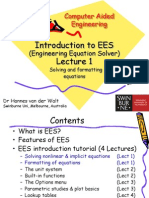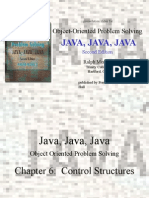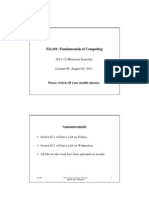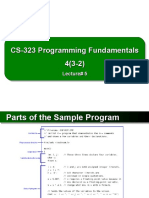0 ratings0% found this document useful (0 votes)
38 viewsOptimizations For The CSE Machine: Programming Language Principles
The document discusses 11 rules for optimizing a CSE machine. The rules include abbreviating unary and binary operators, generating control structures for conditional expressions, using control structures to handle tuples that pop and push values to the stack, and allowing multiple bindings in lambda expressions rather than standardizing comma nodes. The optimizations are presented in a lecture on programming language principles by Manuel E. Bermúdez.
Uploaded by
Mrunal RuikarCopyright
© Attribution Non-Commercial (BY-NC)
Available Formats
Download as PPT, PDF, TXT or read online on Scribd
0 ratings0% found this document useful (0 votes)
38 viewsOptimizations For The CSE Machine: Programming Language Principles
The document discusses 11 rules for optimizing a CSE machine. The rules include abbreviating unary and binary operators, generating control structures for conditional expressions, using control structures to handle tuples that pop and push values to the stack, and allowing multiple bindings in lambda expressions rather than standardizing comma nodes. The optimizations are presented in a lecture on programming language principles by Manuel E. Bermúdez.
Uploaded by
Mrunal RuikarCopyright
© Attribution Non-Commercial (BY-NC)
Available Formats
Download as PPT, PDF, TXT or read online on Scribd
You are on page 1/ 12
Optimizations for the CSE Machine
Programming Language Principles Lecture 13
Prepared by
Manuel E. Bermdez, Ph.D.
Associate Professor University of Florida
Five CSE Rules (Minimally) Sufficient
Let's take some shortcuts. CSE Rules 6 and 7: Unary and Binary Operators.
Five CSE Rules (Minimally) Sufficient (contd)
In the control structures, abbreviate: + to + - to ... (other binary operators) neg to neg not to not In other words, DO NOT standardize unops and binops.
CSE Rule 8: Conditional
Do not standardize node. Instead, for B E1 | E 2, generate then else B, where then = control structure for E1 else = control structure for E2 B evaluated first, then pops the stack, keeps one and discards the other.
CSE Rules 9 and 10: Tuples
Do not standardize "tau. Instead, for a tuple of the form (E1, E2, ..., En), generate the control structure taun E1 ... En. taun will: 1. Pop the top n values from the stack, 2. Create a new n-tuple, 3. Push the tuple on the stack.
Note: tuple elements are evaluated right-to-left.
CSE Rule 11: n-ary Functions
Do not standardize the "," node. Instead, For (x,y).E, simply allow multiple bindings in one environment.
Optimizations for the CSE Machine
Programming Language Principles Lecture 13
Prepared by
Manuel E. Bermdez, Ph.D.
Associate Professor University of Florida
You might also like
- Writing RPAL Programs: Programming Language PrinciplesNo ratings yetWriting RPAL Programs: Programming Language Principles23 pages
- Java, Java, Java: Object-Oriented Problem SolvingNo ratings yetJava, Java, Java: Object-Oriented Problem Solving51 pages
- 4CSPL2011 - Web - Development - Using - Python - Django Question BankNo ratings yet4CSPL2011 - Web - Development - Using - Python - Django Question Bank9 pages
- IT215: Systems Software, Winter 2014-15 First In-Sem Exam (2 Hours)No ratings yetIT215: Systems Software, Winter 2014-15 First In-Sem Exam (2 Hours)9 pages
- Navigating the Core: A Concise Guide to C++ FundamentalsNo ratings yetNavigating the Core: A Concise Guide to C++ Fundamentals9 pages
- PSUC - Lab - List of Experiments - 2023-24 - NNo ratings yetPSUC - Lab - List of Experiments - 2023-24 - N13 pages
- Esc101: Fundamentals of Computing: 2011-12-Monsoon SemesterNo ratings yetEsc101: Fundamentals of Computing: 2011-12-Monsoon Semester7 pages
- CS-323 Programming Fundamentals 4 (3-2) CS-323 Programming Fundamentals 4 (3-2)No ratings yetCS-323 Programming Fundamentals 4 (3-2) CS-323 Programming Fundamentals 4 (3-2)21 pages
- Before Turning On Your Computer: Simple Problem SetNo ratings yetBefore Turning On Your Computer: Simple Problem Set9 pages
- Experiment 8: To Compute The Steady-State Error of Transfer Functions Using MATLABNo ratings yetExperiment 8: To Compute The Steady-State Error of Transfer Functions Using MATLAB8 pages
- Recursion and Fixed-Point Theory: Programming Language PrinciplesNo ratings yetRecursion and Fixed-Point Theory: Programming Language Principles26 pages
- The CSE Machine: Programming Language PrinciplesNo ratings yetThe CSE Machine: Programming Language Principles22 pages
- Lambda Calculus: Programming Language PrinciplesNo ratings yetLambda Calculus: Programming Language Principles26 pages
- LL (1) Parsing: Programming Language PrinciplesNo ratings yetLL (1) Parsing: Programming Language Principles21 pages
- Standardizing RPAL AST's: Programming Language PrinciplesNo ratings yetStandardizing RPAL AST's: Programming Language Principles30 pages
- Building AST's For RPAL Programs: Programming Language PrinciplesNo ratings yetBuilding AST's For RPAL Programs: Programming Language Principles15 pages
- AST Generation: Programming Language PrinciplesNo ratings yetAST Generation: Programming Language Principles21 pages
- Tree Generation: Programming Language PrinciplesNo ratings yetTree Generation: Programming Language Principles26 pages
- Parsing: Programming Language PrinciplesNo ratings yetParsing: Programming Language Principles33 pages
- Introduction and Paradigms: Programming Language PrinciplesNo ratings yetIntroduction and Paradigms: Programming Language Principles19 pages
- Overview of Compilation: Programming Language PrinciplesNo ratings yetOverview of Compilation: Programming Language Principles28 pages
- Notes On Divide-and-Conquer and Dynamic Programming.: 1 N 1 n/2 n/2 +1 NNo ratings yetNotes On Divide-and-Conquer and Dynamic Programming.: 1 N 1 n/2 n/2 +1 N11 pages
- Using DNA To Solve NP-Complete Problems: AbstractNo ratings yetUsing DNA To Solve NP-Complete Problems: Abstract11 pages
- Operating Systems: Thanks For Downloading. Enjoy The ReadingNo ratings yetOperating Systems: Thanks For Downloading. Enjoy The Reading9 pages
- Advantages Relative To Other Search AlgorithmsNo ratings yetAdvantages Relative To Other Search Algorithms7 pages
- Thanks For Downloading. Enjoy The ReadingNo ratings yetThanks For Downloading. Enjoy The Reading15 pages
- What Is Javascript?: Thanks For Downloading. Enjoy The ReadingNo ratings yetWhat Is Javascript?: Thanks For Downloading. Enjoy The Reading24 pages
- Writing RPAL Programs: Programming Language PrinciplesWriting RPAL Programs: Programming Language Principles
- 4CSPL2011 - Web - Development - Using - Python - Django Question Bank4CSPL2011 - Web - Development - Using - Python - Django Question Bank
- IT215: Systems Software, Winter 2014-15 First In-Sem Exam (2 Hours)IT215: Systems Software, Winter 2014-15 First In-Sem Exam (2 Hours)
- Navigating the Core: A Concise Guide to C++ FundamentalsNavigating the Core: A Concise Guide to C++ Fundamentals
- Esc101: Fundamentals of Computing: 2011-12-Monsoon SemesterEsc101: Fundamentals of Computing: 2011-12-Monsoon Semester
- CS-323 Programming Fundamentals 4 (3-2) CS-323 Programming Fundamentals 4 (3-2)CS-323 Programming Fundamentals 4 (3-2) CS-323 Programming Fundamentals 4 (3-2)
- Before Turning On Your Computer: Simple Problem SetBefore Turning On Your Computer: Simple Problem Set
- Experiment 8: To Compute The Steady-State Error of Transfer Functions Using MATLABExperiment 8: To Compute The Steady-State Error of Transfer Functions Using MATLAB
- Recursion and Fixed-Point Theory: Programming Language PrinciplesRecursion and Fixed-Point Theory: Programming Language Principles
- Standardizing RPAL AST's: Programming Language PrinciplesStandardizing RPAL AST's: Programming Language Principles
- Building AST's For RPAL Programs: Programming Language PrinciplesBuilding AST's For RPAL Programs: Programming Language Principles
- Introduction and Paradigms: Programming Language PrinciplesIntroduction and Paradigms: Programming Language Principles
- Overview of Compilation: Programming Language PrinciplesOverview of Compilation: Programming Language Principles
- Notes On Divide-and-Conquer and Dynamic Programming.: 1 N 1 n/2 n/2 +1 NNotes On Divide-and-Conquer and Dynamic Programming.: 1 N 1 n/2 n/2 +1 N
- Operating Systems: Thanks For Downloading. Enjoy The ReadingOperating Systems: Thanks For Downloading. Enjoy The Reading
- What Is Javascript?: Thanks For Downloading. Enjoy The ReadingWhat Is Javascript?: Thanks For Downloading. Enjoy The Reading



















































































